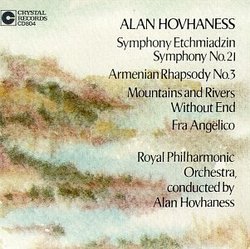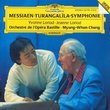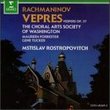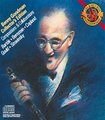| All Artists: Alan Hovhaness, Royal Philharmonic Orchestra Title: Hovhaness: Symphony Etchmiadzin; Armenian Rhapsody No. 3 Members Wishing: 0 Total Copies: 0 Label: Crystal Records Release Date: 8/19/1993 Genre: Classical Styles: Historical Periods, Modern, 20th, & 21st Century, Symphonies Number of Discs: 1 SwapaCD Credits: 1 UPC: 009414780423 |
Search - Alan Hovhaness, Royal Philharmonic Orchestra :: Hovhaness: Symphony Etchmiadzin; Armenian Rhapsody No. 3
 | Alan Hovhaness, Royal Philharmonic Orchestra Hovhaness: Symphony Etchmiadzin; Armenian Rhapsody No. 3 Genre: Classical
|
Larger Image |
CD DetailsSimilarly Requested CDs
|
CD ReviewsBeautiful Music Without End Thomas F. Bertonneau | Oswego, NY United States | 05/31/2003 (4 out of 5 stars) "Yes, yes. Alan Hovhaness (1911 - 2000) wrote too much - so that, if one listened to his catalogue of works one after the other the redundancy-effect would soon come into play. A surfeit of pleasure would neutralize pleasure. One might say the same about Mozart. Imagine listening to all the symphonies, one after the other, in sequence, or all the piano sonatas, or all the operas. The "if one listened to it all..." argument is a sophism. Another, more just, way of looking at the matter is that Hovhaness wrote consistently beautiful and attractive music from the mid-1940s right up until the year of his death. Sample the catalogue at any random point and the discovery is likely to be a pleasant one. The series of Hovhaness discs issued by Peter Christ of Crystal Records offers a case in point. Mainly, these recycle (with new engineering) master-tapes from Hovhaness' own Poseidon label of the 1970s, through the medium of which he offered a representative selection of his many symphonies (latterly sixty-seven in all), with professional orchestras, on long-playing records - with other, smaller works as fillers. A good place to begin in the Crystal series of re-issues of those old Poseidon recordings is the program containing Symphony No. 21 "Etchmiadzin" (1968), the chamber symphony "Mountains and Rivers without End" (1972), and two smaller, but not insignificant, works. "Etchmiadzin" celebrates the national piety of medieval Armenia, the land of Hovhaness' forefathers - like so many of his scores. In three movements, this Symphony uses baroque forms combined with Anatolian modes to create the effect that might have happened had Johann Sebastian Bach hailed from the Caucasus Mountains rather than from Leipzig. The orchestra is baroque: strings, brass, and tympani, as in a Bach suite or overture, with some added, faintly exotic percussion; the expression is controlled rather than wild, as Hovhaness could be in some of his compositions of the mid-1960s and the 1970s. The opening "Andante Maestoso" conveys the pomp and ceremony that Hovhaness imagines for the Tenth-Century religious center of the Armenian faith. The middle-movement "Pavana" calls forth a quieter, but equally pious mood. The conflict inherent in faith - the need to defend belief against unbelief - seems to be the idea in the concluding "Introduzione, Largo Maestoso," which correspond to the Bachian model of a prelude-and-fugue. Many modern people have made what the philosopher William Barrett once called "The Journey to the East." Hovhaness helps to guide us on that journey. The inspiration for "Mountains and Rivers without End" comes from farther afield than the Armenian highlands. The Korean peninsula is its provenance - especially the Sixteenth-Century Korea of those romantic watercolor rolls showing vast, undulating landscapes of mountain and lake, with bucolic scenes. When I first encountered this music, shortly after it appeared on vinyl, I regarded it as perfect for the Bohemian evenings of the time: a jug of wine, a book of verse, and an LP of Alan Hovhaness seemed to me the necessary ingredients of a transcendental experience - especially when I could rope a girl into the formula. (She would constitute the requisite second person, the "thou," of the "Rubaiyat's" recipe for earthly happiness.) My re-reception of the music thirty years later naturally takes coloration from my nostalgia. Yet, as my Brooklyn friend Steve Kogan tells me, nostalgia is a necessary (even if it is not a sufficient) ingredient of maturity. The flutes unfold avian arabesques, the trombones low like kine, the strings make a background out of Hovhaness' patented "spirit-murmur." It is as affecting and innocent as I remember it. When the music ends, I feel a sadness, as though, after a spell of aerial rapture, I descended once more to cold earth. Ideally, it should indeed continue "without end." Alas, we live in the world of time and space. The "Armenian Rhapsody No. 3," although slight, is gorgeous and tuneful. The final item on the program, the "Fra Angelico" Fantasy (1968), might be its composer's most perfect accomplishment. At sixteen minutes' performing-time, it qualifies as substantial; in form, it is a species of passacaglia, with a chorale-tune, eastern in flavor, introduced right away cycling through the instrumental choirs only to reappear in the finale augmented and made splendorous in a true musical apotheosis. I listened to "Fra Angelico" for the first time late at night, on headphones, after purchasing it in the Tower Records in Westwood Village in 1973 or 74 or thereabouts. The gooseflesh has never really gone away. How lovely it is to live in a world where Alan Hovhaness made sublime music! Strongly recommended."
|

 Track Listings (6) - Disc #1
Track Listings (6) - Disc #1








